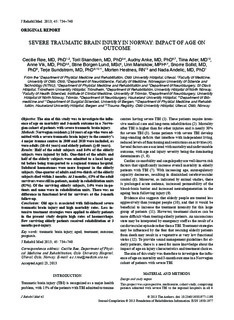| dc.contributor.author | Røe, Cecilie | |
| dc.contributor.author | Skandsen, Toril | |
| dc.contributor.author | Anke, Audny | |
| dc.contributor.author | Ader, Tiina | |
| dc.contributor.author | Vik, Anne | |
| dc.contributor.author | Lund, Stine Borgen | |
| dc.contributor.author | Manskow, Unn Sollid | |
| dc.contributor.author | Sollid, Snorre | |
| dc.contributor.author | Sundstrøm, Terje | |
| dc.contributor.author | Hestnes, Morten | |
| dc.contributor.author | Andelic, Nada | |
| dc.date.accessioned | 2019-10-25T11:51:14Z | |
| dc.date.available | 2019-10-25T11:51:14Z | |
| dc.date.created | 2013-05-17T18:39:35Z | |
| dc.date.issued | 2013 | |
| dc.identifier.citation | Journal of Rehabilitation Medicine. 2013, 45 (8), 734-740. | nb_NO |
| dc.identifier.issn | 1650-1977 | |
| dc.identifier.uri | http://hdl.handle.net/11250/2624462 | |
| dc.description.abstract | Objective: The aim of this study was to investigate the influence of age on mortality and 3-month outcome in a Norwegian cohort of patients with severe traumatic brain injury (TBI).
Methods: Norwegian residents ≥ 16 years of age who were admitted with a severe TBI to the country’s 4 major trauma centres in 2009 and 2010 were included, as were adults (16– 64 years) and elderly patients (≥ 65 years).
Results: Half of the adult subjects and 84% of the elderly subjects were injured by falls. One-third of the adults and half of the elderly subjects were admitted to a local hospital before being transported to a regional trauma hospital. Subdural haematomas were more frequent in the elderly subjects. One-quarter of adults and two-thirds of the elderly subjects died within 3 months. At 3 months, 41% of the adult survivors were still in-patients, mainly in rehabilitation units (92%). Of the surviving elderly subjects, 14% were in-patients and none were in rehabilitation units. There was no difference in functional level for survivors at the 3-month follow-up.
Conclusion: Old age is associated with fall-induced severe TBI and high mortality rates. Less intensive treatment strategies were applied to elderly patients in the present study despite high rates of haemorrhage. Few surviving elderly patients received rehabilitation at 3 months post-injury. | nb_NO |
| dc.language.iso | eng | nb_NO |
| dc.publisher | Foundation for Rehabilitation Information | nb_NO |
| dc.rights | Navngivelse-Ikkekommersiell 4.0 Internasjonal | * |
| dc.rights.uri | http://creativecommons.org/licenses/by-nc/4.0/deed.no | * |
| dc.title | Severe traumatic brain injury in Norway: impact of age on outcome | nb_NO |
| dc.type | Journal article | nb_NO |
| dc.type | Peer reviewed | nb_NO |
| dc.description.version | publishedVersion | nb_NO |
| dc.source.pagenumber | 734-740 | nb_NO |
| dc.source.volume | 45 | nb_NO |
| dc.source.journal | Journal of Rehabilitation Medicine | nb_NO |
| dc.source.issue | 8 | nb_NO |
| dc.identifier.doi | 10.2340/16501977-1198 | |
| dc.identifier.cristin | 1029060 | |
| dc.description.localcode | © 2013 The Authors. Creative Commons Attribution Non-Commercial Licence 4.0 International | nb_NO |
| cristin.unitcode | 194,65,30,0 | |
| cristin.unitcode | 1920,5,0,0 | |
| cristin.unitcode | 1920,16,0,0 | |
| cristin.unitname | Institutt for nevromedisin og bevegelsesvitenskap | |
| cristin.unitname | Klinikk for fysikalsk medisin og rehabilitering | |
| cristin.unitname | Nevroklinikken | |
| cristin.ispublished | true | |
| cristin.fulltext | original | |
| cristin.qualitycode | 1 | |

